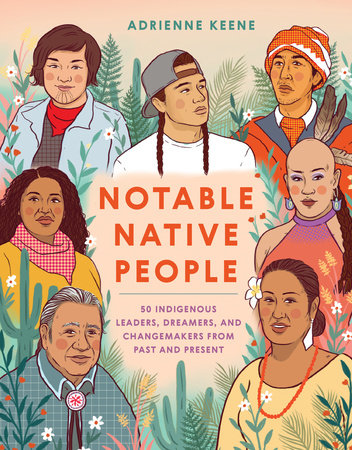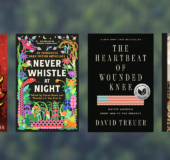Introduction
Into An Indigenous FutureThe United States as we know it has not always existed—there is a deep and rich legacy of people inhabiting these lands long before the first European colonists arrived and altered the course of history. The lands in what is currently known as the United States encompass the homelands of 574 federally recognized American Indian tribal nations, as well as hundreds more state-recognized and non-recognized tribal nations. In addition, through later acts of land seizing—and in the case of the Hawaiian Kingdom, illegal overthrow—our extended Indigenous community also includes Kānaka Maoli and Alaska Native people. These three groups encompass vast diversity—innumerable cultural groups, nations, languages, histories, experiences, struggles, and joys.
Indigenous people are the first people of the lands around the world. To be Indigenous is to be of a place, to have creation stories of how your people emerged from the land, and to be connected to a community from that place. As the first people of their respective lands, American Indian people, Alaska Native people, and Kānaka Maoli have expertly stewarded and cared for the land, built vast cities and societies, utilized democratic governance, and carried and shaped cultural practices and traditions for centuries. But because of the destructive legacy of settler colonialism, most Americans know very little about Native people beyond the stereotypes of Hollywood Indians, igloos, or Hawaiian grass skirts, but our reality is much different. We have—and have always had— leaders across all sectors, from science, art, and activism to education, fashion, politics, and beyond.
I am a Native person who was raised far away from her Cherokee community, surrounded by non-Natives, and educated in predominantly white schools. Growing up, the lesson I learned in school about Indigenous people was that we were people who existed only in the historic past, that we and our cultures were extinct and had no connection to the present day. I never learned about any Native people other than historic male leaders like Sitting Bull and Geronimo, and I was surrounded by images in popular culture of harmful stereotypes. But this narrative of Native people couldn’t be more wrong. We are not extinct, and there are so many important Native people of the past and today whose stories and lives have resonance, power, and are worth learning about. Now, as a scholar who studies, writes, and teaches about the importance of representation, I know the power of sharing stories that push beyond stereotypes and move Indigenous people from the historic past into the modern present and the future.
Not only are most of the images and stories we hear about Native people stereotypical, Indigenous people are also largely invisible in American culture. This invisibility is reflected in Hollywood, the media, education, statistics—everywhere—and it didn’t just happen: it’s a direct result of the ongoing genocidal policies and practices of colonization. But the Indigenous world I know is dramatically different. When I open my social media feeds each day, I see a world full to the brim of Indigenous joy, vibrant cultural revitalization, Native babies speaking their languages, Native fashion shows, Indigenous futurisms, awe-inspiring beadworkers, hilarious Indigenous memes, resilience, and brilliant community-focused work. In my life, work, and writing, I want to showcase a bit of that Indigenous brilliance and joy, because it gives me so much hope.
Being in this community has also introduced me to amazing Indigenous people I would never have encountered otherwise.
Indigenous Goddess Gang, an online community and magazine started by Kim Smith, who is Diné, has a “Matriarch Monday” feature, where they post a different Native woman from history each week—it is how I first learned about several of the women in this book. Every Monday, I am so excited to see a Native person represented in a position or point in history that I had never known about. American history has purposely written Natives out of the national narrative, because our continued existence serves as a reminder that this country exists on stolen lands and was built by attempting to destroy millions of Indigenous people. Therefore, the work
of uncovering the stories of Native people unknown to most of the public is important decolonial work, and there’s still so much for us all to learn.
Because there was no way that just the fifty people in this book could equitably represent the full spectrum of such beautifully diverse Indigenous people, I strived to curate a balanced group. The people in this book represent a small slice of the Native experience, balanced across the three broad cultural groups of American Indian, Alaska Native, and Kānaka Maoli, as well as various gender identities, ages, locations, tribal affiliations, and work. I also intentionally focused on the inclusion of Black Native, female, LGBTQ+ and Two Spirit people. In the spirit of Indigenous relationships, I created the list of people in this book collaboratively and vetted the final group with community members and friends to ensure it maintained this spirit of inclusion. All of that said, this is in no way even close to representative of the incredible stories and perspectives of all Indigenous people. I hope this book inspires you to seek out more stories, listen to Native voices, and learn from the first people of this land.
Our world is in a time of dramatic change. Political unrest and climate change have caused an increasingly uncertain future. Our people lived on this land for millennia prior to colonization, and I believe that Indigenous knowledge holds the key to the future. We have survived genocide, and our communities continue to advance, grow, develop, and change while maintaining our cultural roots. Given the opportunity, I know that our experiences and knowledge could turn things around. In order to embrace this Indigenous future, we need to learn from our present and our past. A common refrain about Indigenous representation is “we are still here,” which is a powerful reminder that in spite of everything, we haven’t been erased. I hope that this book and the stories of these incredible individuals can help us to see that not only are we still here, we have always been here, and always will be.
Copyright © 2021 by Adrienne Keene, illustrated by Ciara Sana. All rights reserved. No part of this excerpt may be reproduced or reprinted without permission in writing from the publisher.




